Katrina Otto, Managing Director & Owner of Train IT Medical, undertook an independent study tour in the United States. She found valuable learnings in relation to both technology use and team based care.
Part 1 – excerpt published in Australian Practice Nurses Association (APNA) ‘Primary Times’, April 2019.
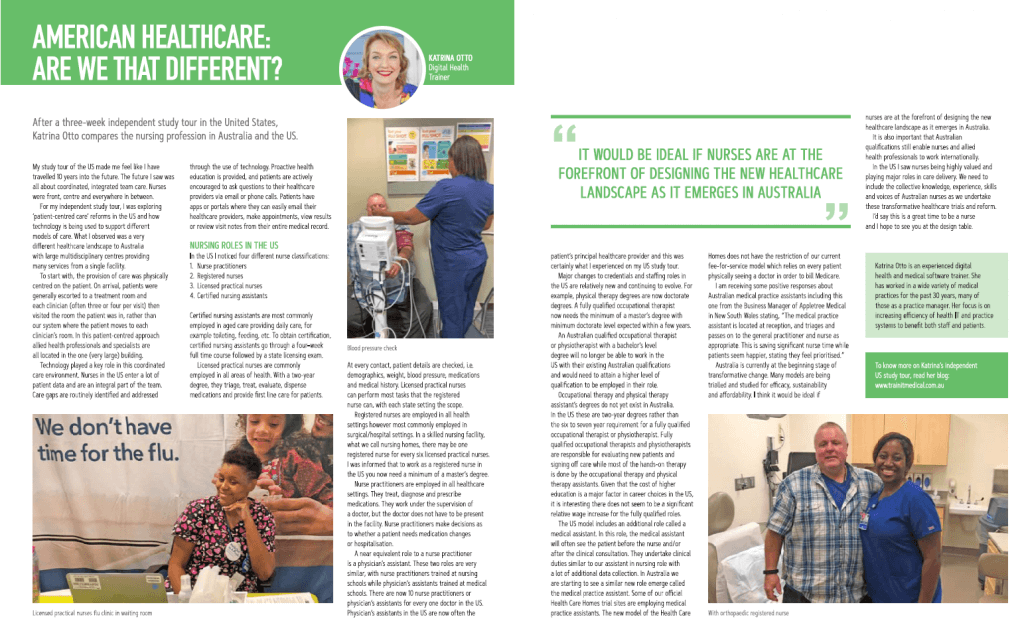
For my 3 week independent US study tour, I was exploring US ‘patient-centred care’ reforms in the US and how technology is being used to support different models of care. What I observed was a very different healthcare landscape to Australia with large multi-disciplinary centres providing many services from a single facility.
To start with, the provision of care was physically centred around the patient. On arrival, patients were generally escorted to a treatment room and each clinician (often three or four per visit) then visited the room the patient was in, rather than our system where the patient moves to each clinician’s room. In this ‘patient-centred’ approach allied health professionals and specialists are all located in the one (very large) building.
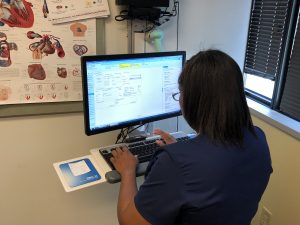
Technology played a key role in this co-ordinated care environment. Nurses in the US enter a lot of patient data and are an integral part of the team. ‘Care gaps’ are routinely identified and addressed through use of technology. Proactive health education is provided, and patients are actively encouraged to ask questions to their healthcare providers via email or phone calls. Patients have apps or portals where they can easily email their healthcare providers, make appointments, view results or review visit notes or their entire medical record.
Nursing Roles in the US
In the US I noticed four different nurse classifications:
- Nurse Practitioners (NP)
- Registered Nurses (RN)
- Licensed Practical Nurses (LPN)
- Certified Nursing Assistants (CNA)
Certified Nursing Assistants are most commonly employed in aged care providing daily care, for example toileting, feeding etc. To obtain certification, certified nursing assistants go through a four-week full time course followed by a state licensing exam.
Licensed Practical Nurses are commonly employed in all areas of health. With a two-year degree, they triage, treat, evaluate, dispense medications and provide first line care for patients.
At every contact, patient details are checked ie demographics, weight, blood pressure, medications and medical history. Licensed practical nurses can perform most tasks that the registered nurse can, with each state setting the scope. Read more about LPNs.
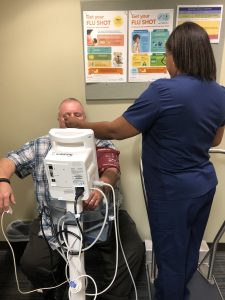
Registered Nurses are employed in all health settings however are most commonly employed in a surgical/hospital setting. In a ‘skilled nursing facility’ (what we call nursing homes) there may be one registered nurse for every six licensed practical nurses. I was informed that to work as a registered nurse in the US you would now need a minimum of a master’s degree.
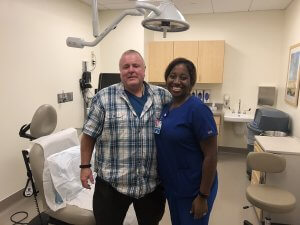
Nurse Practitioners are employed in all health care settings. They treat, diagnose and prescribe medications. They work under the supervision of a doctor, but the doctor does not have to be present in the facility. Nurse Practitioners make decisions as to whether a patient needs medication changes or hospitalisation. Read more about NPs.
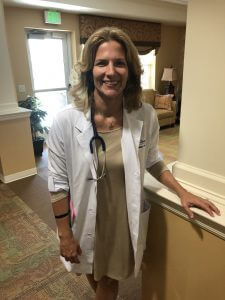
A near equivalent role to a nurse practitioner is a physician’s assistant (PA). These two roles are very similar, with nurse practitioners training at nursing schools while physician’s assistants train at medical schools. I’m told there are now ten nurse practitioners or physician’s assistants for every one doctor in the US. Physician’s assistants in the US are now often the patient’s principal healthcare provider and this was certainly what I experienced on my US study tour. Read more about physician’s assistants.
Allied Health Professionals
Major changes to credentials and staffing roles in the US are relatively new and continuing to evolve. For example, physical therapy degrees are now doctorate degrees. A fully qualified occupational therapist now needs the minimum of a master’s degree with minimum doctorate level expected within a few years.
An Australian qualified occupational therapist or physiotherapist with a bachelors level degree will no longer be able to work in the US with their existing Australian qualifications and would need to attain a higher level of qualification to be employed in their role.
Occupational therapy & physical therapy assistant’s degrees do not yet exist in Australia. In the US these are two-year degrees rather than the six to seven year requirement for a fully qualified occupational therapist or physical therapist. Fully qualified occupational therapists and physical therapists in the US are responsible for evaluating new patients and signing off care while most of the hands-on therapy is done by the occupational therapy and physical therapy assistants. Given that the cost of higher education is a major factor in career choices in the US it is interesting there does not seem to be a significant relative wage increase for the fully qualified roles.
Australia is at the beginning stage of transformative change
In my previous blog ‘Ensuring health equality for all‘ I talked about my experience working with people who had become homeless in the US due to unpaid medical bills. I had, and still have, major concerns with many aspects of the US healthcare system. Real stories I heard from the health professionals I interviewed horrified me.
On this study tour I accompanied patients on their medical visits as a ‘family friend’. I interviewed dozens of health professionals. Compared to Australia, the team-care I saw from the health professionals in the US was enviable. I saw nurses being highly valued and playing major roles in care delivery, working side-by-side with allied health professionals and doctors in co-ordinated teams.
In the US I saw technology that is currently my dream for Australia. I saw patient-centric technology, designed with the purpose that patients will access their electronic health record and communicate easily with their healthcare team. In Australia we have provider-centric technology: records are often described as ‘a memory aid for the doctor’. Medical records, while mostly electronic, are kept in individual medical practices with little or no access by patients or even other healthcare providers who are part of the patient’s broader healthcare team. Printing and faxing is still how we predominantly share information.
There are many lessons to be learnt and improvements we could make in regard to technology design, use and access. There are many lessons to be learnt in regard to team based, patient centred care.
Now is the time Australia!
New models of primary care are being trialled and studied for efficacy, sustainability and affordability. There are many innovative doctors at the forefront of trialling new systems which is fantastic. Let’s provide all the support we can. We need to also include the collective knowledge, experience, skills and voices of nurses and allied health professionals and all work together as we undertake these transformative healthcare trials and reform.
Hope to see you at the design table!
Subscribe to receive Train IT Medical blogs directly
Blog Part 2:
US ‘Medical Assistant’ versus Australia’s ‘Medical Practice Assistant’
In Part 2 of this blog I will detail Australia’s emerging role of the ‘Medical practice assistant – MPA’ and compare to the role of ‘medical assistant – MA’ I observed in the US.
